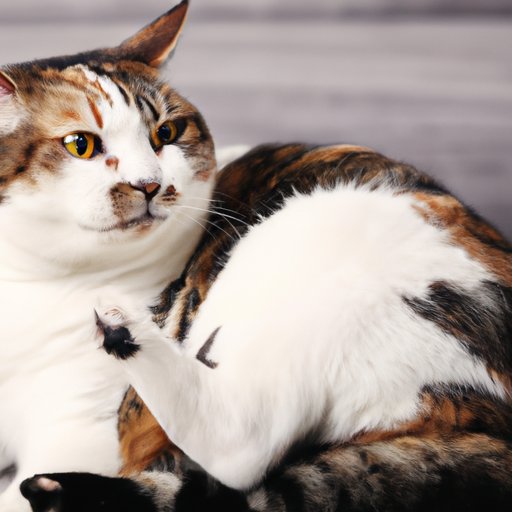
Introduction
Cats are known for being independent and self-sufficient creatures, but they can still experience stress from a range of situations and experiences. In this article, we’ll explore the physiology of feline stress, the hidden dangers of stress in cats, the most common stressors for cats, how to recognize the warning signs of a stressed-out cat, and when stress becomes dangerous and can lead to illness and death. Whether you’re a seasoned cat owner or brand new to the world of feline care, this guide will provide helpful information for keeping your pet healthy and happy.
The Physiology of Feline Stress
When a cat experiences stress, the body responds by releasing hormones such as cortisol and adrenaline. This triggers the “fight or flight” response, which increases heart rate and breathing, prepares muscles for action, and diverts blood from nonessential organs (like the digestive system) to the muscles. These changes can be helpful in the short term, helping the cat respond to a potential threat or danger. However, when stress is chronic, the physiology of the body can become unbalanced, leading to long-term consequences.
Chronic stress in cats can have a range of negative health effects, including weakened immune system function, digestive issues, and increased risk of disease. Stress can also contribute to negative behaviors, like scratching or spraying, that can cause problems in the home environment.
The Hidden Dangers of Stress in Cats
Stress can affect cats in many different ways, both physically and mentally. One of the most common consequences of stress is a weakened immune system, which can make cats more vulnerable to infectious diseases like upper respiratory infections. Stress can also contribute to inflammation in the body, which can increase the risk of chronic diseases like diabetes and heart disease.
In addition to physical health issues, stress can also impact your cat’s behavior. Stressed cats may exhibit increased aggression, scratching, or urine marking, which can be frustrating for owners.
In some cases, stress can even lead to depression in cats. Depressed cats may lose interest in food and play, stop grooming themselves, and become withdrawn or lethargic.
Fortunately, there are a range of strategies that cat owners can use to help reduce the risk of these negative outcomes.
The Most Common Stressors for Cats (and How to Avoid Them)
There are many things that can cause stress in cats, including changes in their environment or routine, loud noises, new pets or people, and too little or too much attention from their owners. Understanding the triggers that cause stress in your cat can help you take steps to avoid or minimize those situations.
For example, cats are known for being creatures of habit, so changes in their routine or environment can be particularly stressful. To minimize disruption, make changes gradually and give your cat plenty of time to adjust. When introducing new pets or people to the home, take things slowly and supervise interactions carefully to prevent overwhelming your cat.
Another common source of stress for cats is the litter box. Cats are naturally clean animals and can become stressed by a dirty or crowded litter box. Make sure your cat has access to a clean, quiet, and private litter box that is cleaned regularly.
How to Recognize the Warning Signs of a Stressed-Out Cat (And What to Do About It)
As a cat owner, it’s important to be aware of the behavioral and physical cues that might indicate that your cat is feeling overwhelmed or anxious. These can include hiding, decreased appetite, excessive grooming, aggression, or changes in urination or defecation habits.
If you suspect that your cat is experiencing stress, there are a range of strategies you can use to help. For example, providing plenty of environmental enrichment, like toys and scratching posts, can help keep your cat mentally stimulated and provide an outlet for stress. Ensuring that your cat’s feeding and play schedule is consistent can also help reduce anxiety.
In some cases, you may need to consult with your veterinarian to develop a more comprehensive plan for managing your cat’s stress. This can include medications or supplements that can help reduce anxiety, or behavioral therapy to help address negative behaviors.
When Stress Becomes Dangerous: How Severe Stress Can Lead to Illness and Death in Cats
While some stress is normal and can even be beneficial in the short term, chronic or severe stress can have serious health consequences for cats. In addition to the behavioral and physical symptoms mentioned earlier, chronic stress can also increase the risk of serious illnesses like heart disease, cancer, and kidney disease.
In some cases, stress can even be life-threatening for cats. For example, sudden and severe stress can trigger a condition called feline idiopathic cystitis (FIC), which can cause urinary blockages that are extremely painful and can be fatal if left untreated.
If you suspect that your cat is experiencing severe or chronic stress, it’s important to consult with your veterinarian right away. They can help diagnose any underlying health issues and provide guidance on effective treatment strategies to help keep your cat healthy and happy.
Conclusion
While stress is a normal part of life for many cats, it’s important for owners to be vigilant about the potential negative effects of chronic or severe stress. By understanding the physiology of feline stress, the hidden dangers of stress, and the most common stressors for cats, owners can take proactive steps to keep their pets healthy and happy. By observing your cat’s behavior, recognizing the signs of stress, and working with your veterinarian to develop an effective treatment plan, you can help ensure a long and happy life for your feline companion.





